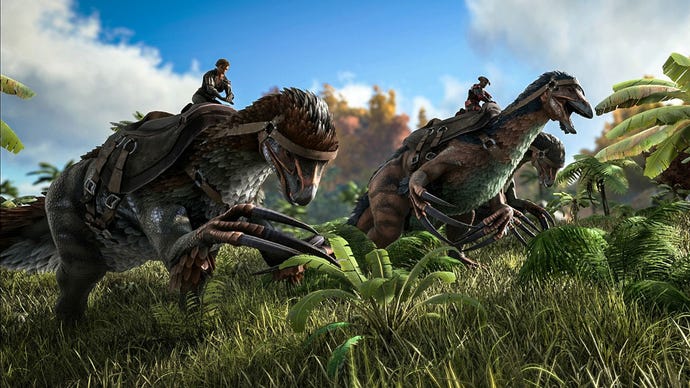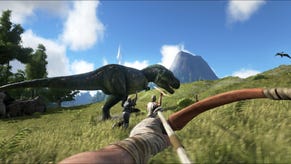Ark: Survival Evolved guide to dinosaur taming
It's a big, scary world out there, and a dino buddy is going to come in handy.
You’ll need to get yourself some dino pals if you want to harvest resources efficiently, and more importantly, ride them around like mister big balls.
If you're not quote ready for that responsibility, you can prep by checking out our 9 essential tips for starting out in Ark: Survival Evolved.
The basics of taming
Animals can be tamed either by knocking them unconscious - which is a necessity for those who are eyeing you up as a mid-morning snack - or by feeding them.
Either way, you’ll need plenty of food - preferably your target’s favourite snack - and Narcoberries if you plan on going down the force-feeding-while-unconscious route.
Taming docile creatures
If you’re going after a docile animal, map the food you’re going to feed it to your hotkey bar. Approach the animal and feed it when the on-screen prompt pops up.
Depending on the animal, you may need camouflage to approach so that it doesn’t bolt when it sees you.
Be prepared to follow it around like a lackey until it’s feeling peckish again, and proffer the food up to it once more. It’s best not to touch the animals during the taming process, as some will attack.
If you wander too far away or leave too long between feeds, any progress you’ve made will be reset.
Taming carnivores and difficult creatures
When you’re ready to tame carnivores and the more difficult animals, you’ll need to render them unconscious. Blunt weapons like a club or prod are ideal, as is the slingshot. If you’ve managed to get your hands on a bow, crossbow, or rifle, tranquiliser arrows and darts will also do the job.
Our Engrams guide has more on crafting recipes for useful weapons and tools.
The next step is to feed it whilst keeping it unconscious. Stock up its inventory with food so that it has something to nibble on when it gets hungry, and force feed it Narcoberries or Narcotics to keep it under.
The process can take a while, so stay on the lookout for predators and players who look like they might want to interfere.
The fastest way to tame creatures is to feed them their favourite food. If they wake up before you’ve tamed them, you’ll lose everything in the animal’s inventory and any progress you’ve made.
If you run out of Narcoberries, you can always resort to punching an animal to stop it from coming to, or use a tranquiliser. Punching it means that it'll take damage, reducing the taming effectiveness, and you run the risk of accidentally killing it. So don’t run out of Narcoberries.
Mastering taming
As with any game, knowledge is key. There’s a great - unofficial - companion app called A-Calc that acts as a taming calculator and has in depth stats on each creature
For a quick and dirty guide, an animal’s favourite food will move the taming process along quicker, while kibble will push it along even more so. Particularly their favourite kibble.
There are different kibble recipes and each animal type has their preferred kibble. Kibble is great for keeping your pets fed after you’ve tamed them as it doesn’t spoil as fast as regular food, so if you’re going to be offline for a while, keeping their inventory stocked with kibble is a good idea.
When it comes to herbivores, any vegetation will do the job as well as any other. Carnivores on the other hand prefer Raw Prime Meat over all other food, which is trumped by their kibble of choice.
Housing tamed creatures
Your pals are going to need somewhere safe to bunker down when you’re not around to watch them.
It’ll keep them out of harm’s way - both from hostile animals and players alike. You’ll need to think about whether you want a simple pen comprised of a fenced area and a dinosaur gate, or something more fortified, using foundations and a roof, to protect against aerial attacks.
Whether you’re playing PvP or PvE will factor into that decision.
Levelling up tamed creatures
If, like me, the thought of your virtual pet getting killed fills you with unfounded - but very real - dread, the simplest way to level it up is to use it to grub around for resources. You're going to need a bunch of them anyway. You can check out our resource locations and harvesting guide for more info.
Alternatively, if you’re in a tribe, you can use the bonus XP to level up your buddy. You’ll need a member of your tribe to mount your animal while you carry out tasks in the immediate vicinity that award XP, like crafting.
For more on levelling up, check out our character levelling guide.
If you’re feeling confident in your dinos abilities or simply don’t care about its wellbeing, then taking into battle and having it kill other animals is the most efficient way to level it up. The more difficult the target, the greater the XP.
Recommended tames
Anklyosaurus
The Anklyo is the best dino for gathering metal, crystal, and flint. It can also gather stone, wood, and thatch, but with less efficiency. It’s not too shabby at getting oil from underwater either
The Anklyo is big and bulky with a decent carrying capacity. It’s a perfect tank and is great for transporting materials even though it’s on the slow side.
Pteranodon
Sooner or later, you’re going to need to get your hands on one of these little buggers.
They make getting around a lot safer and easier, plus you can do a little recon while you’re flapping about in the clouds.
As an added bonus, Pteros can snatch players from mounts, and carry other dinos.
Dilophosaur
While not the best and brightest Ark has to offer, Dilos are a solid starter dino to get on side. They’re fairly easy to tame and are happy to lug around your belongings.
They’re not that strong, so it’s a good idea to nab yourself a few. They spit venom which will be beneficial if you’re set upon by high level players or aggressive dinos, buying you enough time to make an escape.
If you opt to use them for combat, or for guarding rooms inside your base - thanks to their compact size - be prepared to potentially lose them in battle.
Dinosaur eggs
Eventually, breeding dinosaurs is going to be a lot less of a kerfuffle than going out and taming them.
Unfortunately you can’t hatch eggs you stumble across. Instead you’ll have to play matchmaker with tamed dinos to get them to do the business.
Get a male and female of the same species into a pen and enable wandering. When they get close enough to one another, a mating bar will appear, and you’ll need to ensure they stay in close proximity until the bar fills up, otherwise you’ll have to start over.
Successful mating will result in an egg or a pregnancy.
Females have a cooldown on their mating bars once they’ve laid an egg or given birth, while male dinos are always raring to go.
A fertilised egg will have a health bar, and you have to maintain it by regulating the temperature. The required temperature to incubate an egg varies between species so keep an eye on the HUD.
To warm an egg you can pop it down next to a torch or campfire. To cool it down, submerge it in water, or use an air conditioner (level 61 Engram).
If you need to interrupt incubation, you can store eggs in a refrigerator (level 60 Engram) without being penalised.
Different species’ eggs will require different incubation times.
Raising baby dinos
Once the egg has hatched - or the pregnant animal has unloaded its baby - you’ll have to step up to your responsibilities and take care of the thing.
Because they’re so fragile with a barely any HP, you should store the babies in a pen so you can keep an eye on them.
They’ll need regular feeding and monitoring until they reach 10% maturity, after which they can feed themselves, so keep a trough full of food nearby.
Be sure to disable wandering, as it’s on by default on all newborns.
A baby is a big responsibility and is an undertaking for a tribe ideally, as you’ll struggle to raise it on your own.
Have you got any taming or breeding tips of your own? Share them in the comments.






.jpg?width=291&height=164&fit=crop&quality=80&format=jpg&auto=webp)












